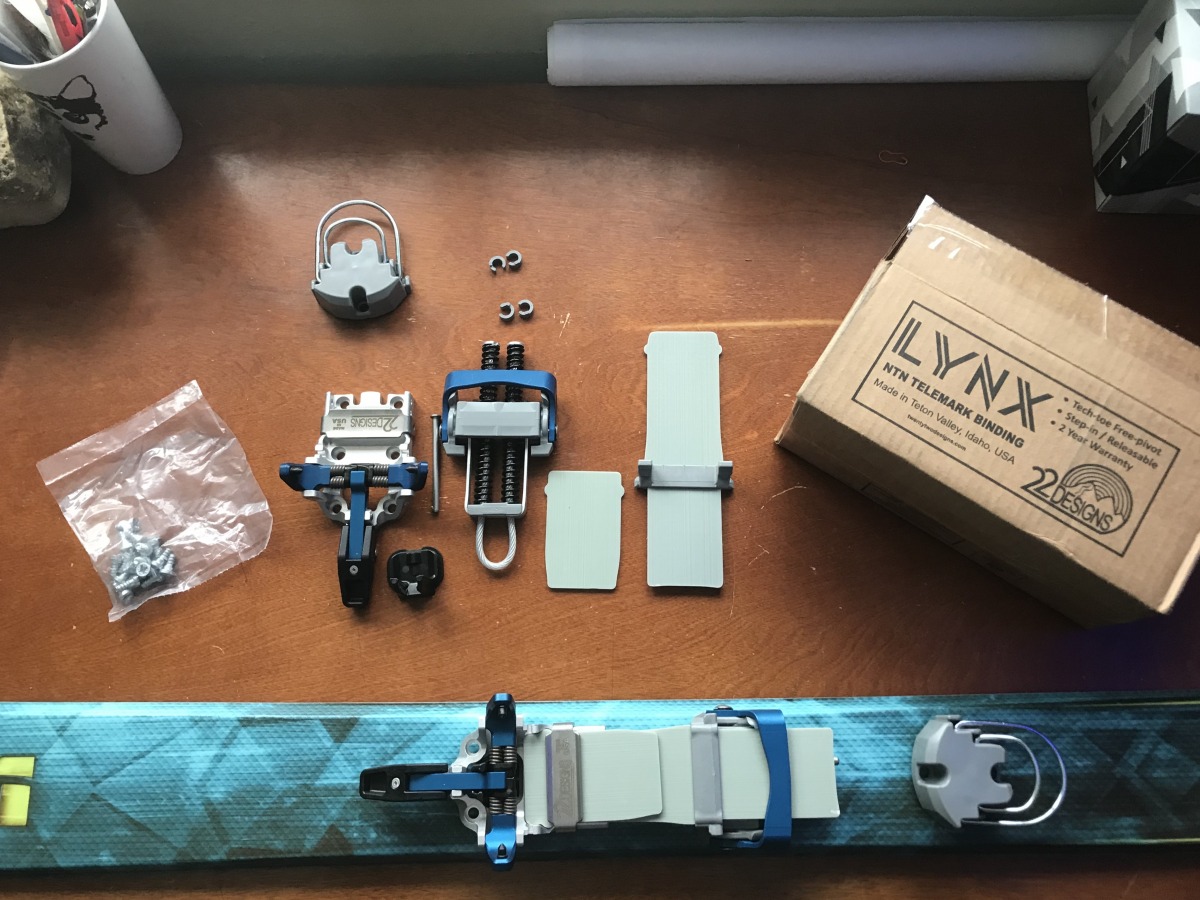
The 22 Designs Lynx in its component pieces, and dry assembled on the ski. The tech toe design, and climbing heel bails are a familiar riff; the innovation in the Lynx is in the combination of composite leaf spring plates, and coil springs. The plates provide the primary resistance, while the main function of the coil springs is to lock in the claw at the 2nd heel. Spacers for the coil springs allow for adjustment of claw tension.
Acquiring a taste for ski touring after nearly two decades on mountain bikes has decidedly influenced my perception of skiing. On one hand, I’m amazed by the terrain that I can access on skis in the winter. The freedom of exploration – not bound by a trail, able to choose any line your skill set can handle, floating over the brush, downed timber, and rocks that render these lines impractical any other time of the year is the alluring magic I look forward to when the snow starts to fly.
Juxtaposed against this freedom is the enormous fiddle factor required to switch between uphill and downhill modes. Even the most adroit of ski-mo transitions, honed by intentional practice, and enabled by a well-trained physique is an absolute gong show compared to the ease of simply pressing a dropper post trigger, or reaching for a lock out switch.
What if transitions could be reduced to something approximating the seamless efficiency of mountain biking? How much otherwise skiable terrain do we bypass for the fact that we cannot justify the time spent in transition? This is the thought that rolls around in my head on flat approaches to steeper terrain, as I cast a longing eye towards small, but inviting runs.
Recent hybrids of the tech binding with the free-heel concept point towards an alternative future for telemark. This season I put together a kit designed to maximize efficiency and unlock otherwise overlooked terrain: Voile Ultra Vector BC skis with 22 Designs Lynx bindings and Scarpa TX Pro boots. Here’s an overview of each piece.
Voile Ultra Vector BC Ski
Climbing pattern skis are the oddball child of cross country efficiency, and powder-fever touring. Researching this often-overlooked segment of skis reveals a fascinating array of contradictory feedback. Some users claim to ascend 20% slopes no problem. Detractors say they are barely good for 5%. Reading between the lines, it seems that snow conditions may have the biggest influence on the effectiveness of fish scale patterns. Sifting through varying reports, the Voile BC series consistently gets the highest praise for having the most effective climbing pattern, and the SuperCharger profile is well established as a Goldilocks ski with just the right balance of flotation, and edge carving.
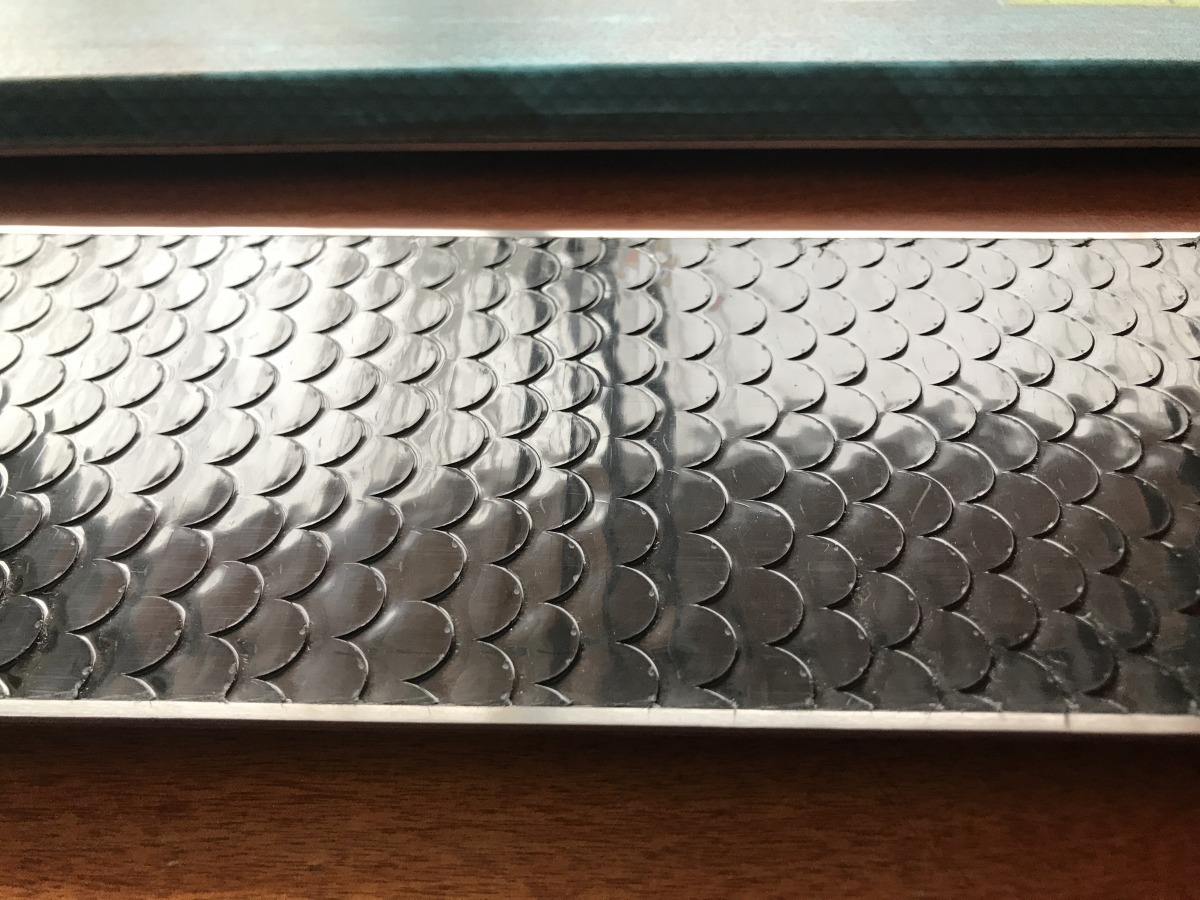
Not the fish scales that you think. The Voile scale pattern works opposite of how I had expected when looking at online pictures. The “V” shape between the scallops generates climbing traction by forcing the snow to compact into a point.
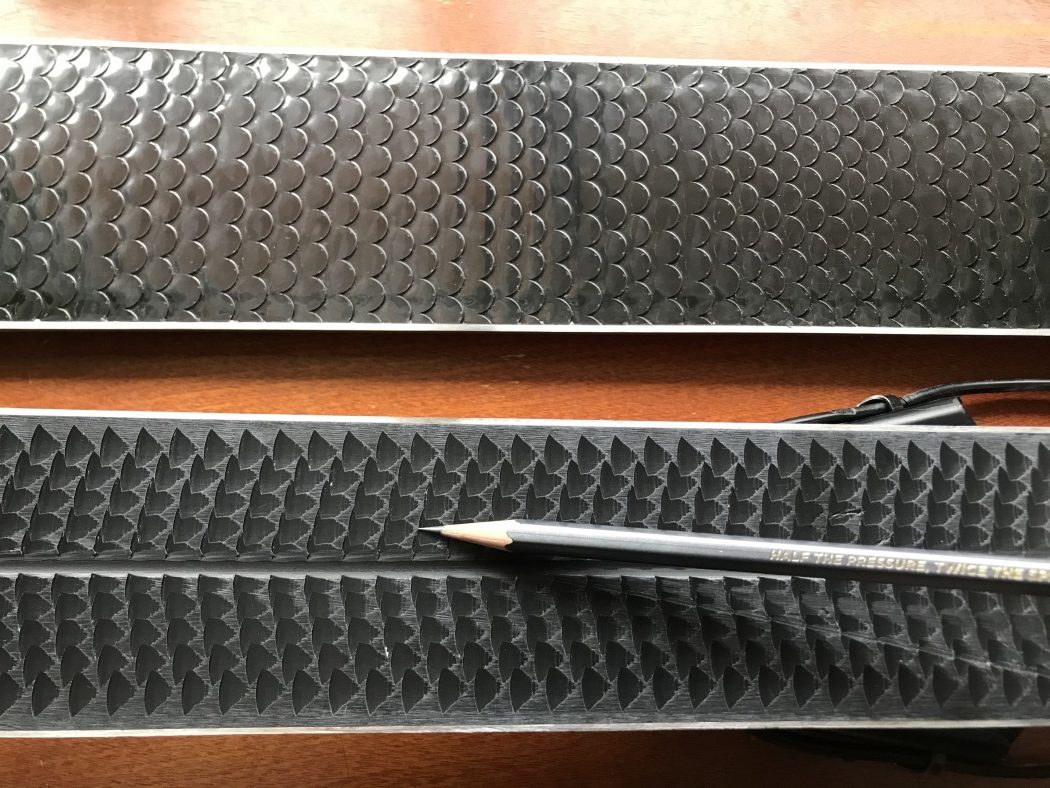
The Fischer climbing pattern is almost the opposite of the Voile pattern. The fan shape of the Fischer pattern relies on the snow packing into a broad arch rather than the narrow, concentrated point of the Voile pattern. Hopefully the narrower pattern of the Voiles will translate into a significant improvement in climbing performance.
My current ski quiver ranges from wide, to wider; the Voile Ultra Vector BC in 177 cm, which specs out at 130 tip, 96 waist, 114 tail, with a radius of 19.5 meters will be the smallest ski I’ve ventured off piste with. In addition to gaining climbing and traversing efficiency by having a smaller, lighter ski, I am looking forward having a set of sticks that will make spring tours on firmer snow more appealing than the 120+ skis I rely on for prime powder conditions in the depth of winter.
Shop for the Voile Hyper Vector BC
22 Designs Lynx Binding
The 22 Designs Lynx is one of the most promising options of the tele tech contenders. A 2 pin toe design provides free-pivot touring, while a combination of composite plates over coil springs provides the necessary tele resistance. The composite plates act as leaf springs, providing the primary resistance, and have been beefed up for 2020 (0.115” v 0.1”). A plate and Slic Pin arrangement combined with 3 different pivot point locations provide adjustment for how stiff, or “active” the leaf spring engagement is.
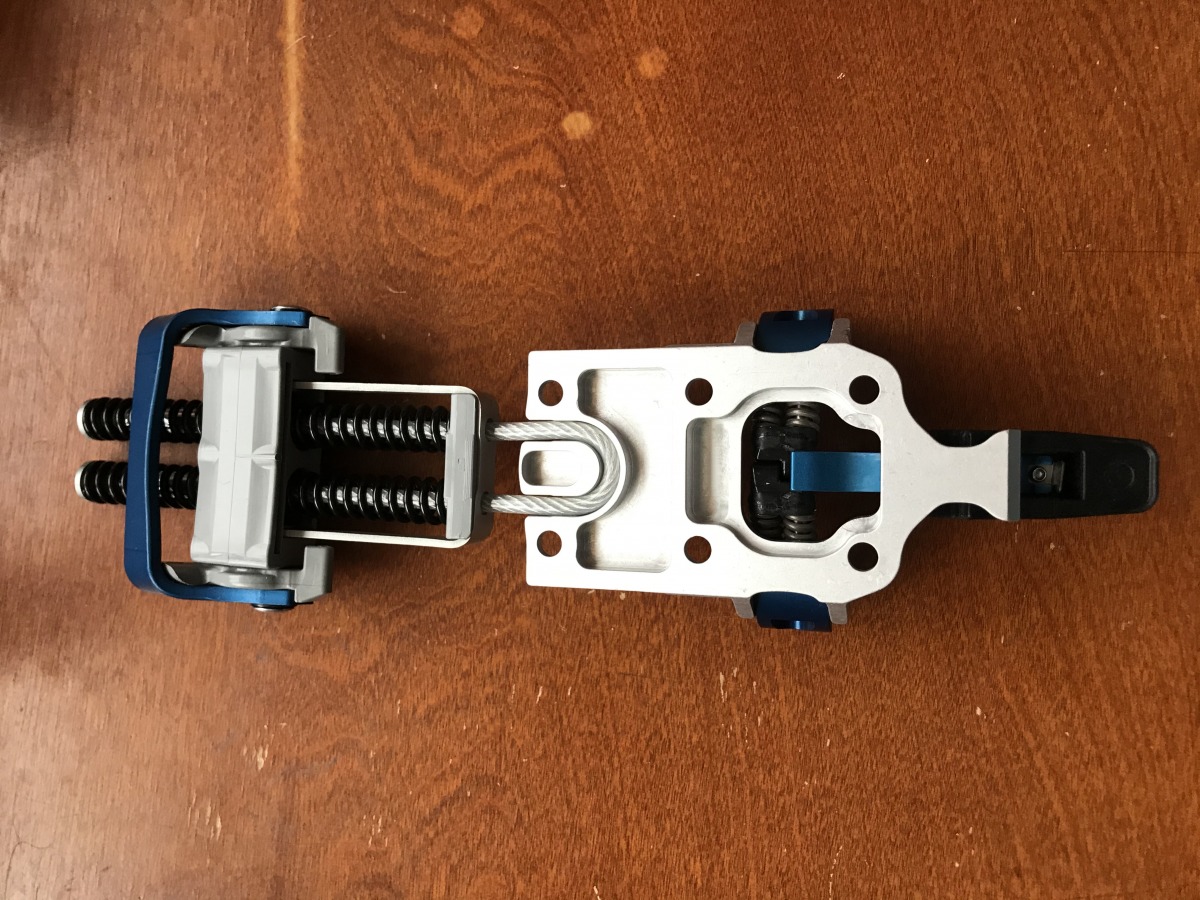
A U-shaped groove in the bottom of the toe piece holds the cable & coil spring arrangement of the claw captive once mounted to the ski.
The coil springs below the composite plates are primarily to provide the necessary tension to lock the claw / 2nd heel into place, and provide a supplemental amount of tele resistances. Spacers for the coil springs are included to dial in the tension of the claw. Other reviewers have noted having to add spacers almost immediately to compensate for the springs taking a set with use. The 2020 springs are supposed to be stronger; I’ll hold off on adding spacers unless absolutely necessary in interest of optimizing traverses while in ski mode.
Accessing the touring mode is achieved by changing the position of the claw / 2nd heel just behind the ball of the foot. While it is possible to switch from tour to ski mode with boots on the skis, going from ski mode back to tour requires stepping out of the binding to flip the claw back down.
Stated weight is 1000 grams / 2.2 lbs, which has it nearly pound lighter than the Voile Switchback, and the Salomon Shift binding, but nearly 3 times as heavy as Dyna Fit Speed Radical at 365 grams.
Scarpa TX Pro
Like any good telemarker, I started my foray into the world of knee-dropping turns on used gear, cycling through second hand boots acquired for less than the cost of a day pass on the lifts. As I cast my eye towards the tele tech revolution, it became clear that a wholesale upgrade would be necessary to take advantage of the new dawning.
Scarpa TX Pros are the benchmark boots of the tele tech world, known for having a “just right” flex, and the advancements of a tech toe fittings paired with an NTN sole. Boasting 4 buckles, and a weight of 1750 grams, they are much more akin to burly freeride boots than svelte ski mo offerings. For as much as “freedom of movement” is associated as being the hallmark of the tele experience, the range of motion in walk mode is astonishingly limited at 22 degrees. Even the Maestrale XT, the cliff-huckingest boot of Scarpa’s touring lineup has vastly more range of motion at 56 degrees.
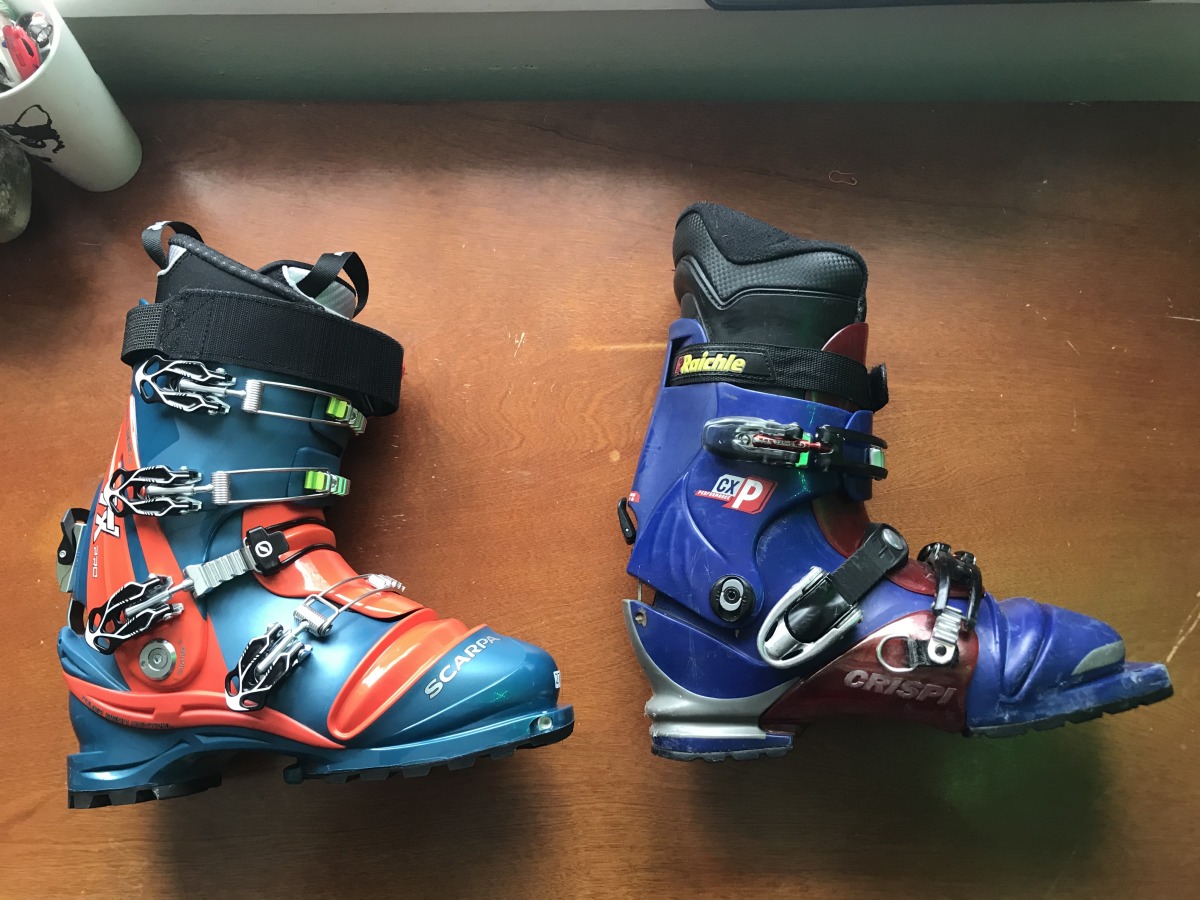
New(ish) tech v. old school cool. The Scarpa TX Pro is obviously a much beefier boot than my well-worn, 2nd hand Crispi CxP. The instep buckles of the Scarps are one of their trademark features, said to provide a more secure tele flex.
While bindings such as the Lynx are proof that innovation is happening in telemark technology, it’s a bit disappointing to have boot choices limited to reluctant retrofits to boot designs that hearken from the dawning ages of the Internet.
Pierre Mouyade, creator of the Meidjo binding (other primary competitor / option to the 22D Lynx in the tele tech world), has been lobbying for an industry standard spacing for the distance between the tech fittings, and the back of the NTN sole. While this would seem to apply only the telemark world, the armchair engineer in me wonders if establishing this standard could lead to innovation that would benefit alpine touring as well. By opening up more real estate to work with at the toe of the boot, perhaps both tele, and alpine skiers could benefit from finally having the elusive retention, and release factors that have so long avoided the tech toe platform?
Carpet testing compared to my well-worn Crispis shows the Scarpas to be much stiffer (and squeakier) boots, with significantly less range of motion. Will the TX Pros break in, and gain some additional flexibility? Will they charge so awesome on the downs that I won’t care? Having experienced the magnificent range of motion that modern ski-mo inspired touring boots provide, it’s hard to imagine being completely satisfied with the range of motion that is currently considered acceptable for tele boots.
Winter has finally come to Colorado, and my favorite low-angle, low-altitude haunts are filling in. The West Elk trails, is a small set of cross country ski loops in the Flat Tops just south of Silt, CO. The xc trails serve as a way to link up short runs down into the drainages once the brush and timber is covered. If the climbing pattern bases of the Hyper Vector skis are effective enough to scale the low-angle terrain without having to resort to skins, and the Scarpa boots have enough “walkablity” to be reasonably efficient on the traverses, it will make lapping the short runs that much more enjoyable without having to worry about the hassle of swapping skins.
Stay tuned for full reports on each piece of gear later this season.
Aaron Mattix grew up in Kansas and wrote a report on snowboarding in seventh grade. His first time to attempt snowboarding was in 2012, and soon switched over to skis for backcountry exploration near his home in Rifle, CO. From snow covered alleys to steeps and low angle meadows, he loves it all. In the summer, he owns and operates Gumption Trail Works, building mountain bike singletrack and the occasional sweet jump.
